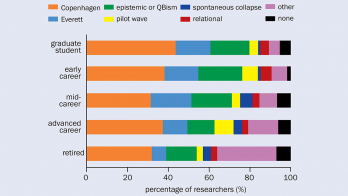The Beauty of Falling: A Life in Pursuit of Gravity, by Claudia de Rham, Princeton University Press

A theory of massive gravity is one in which the graviton, the particle that is believed to mediate the force of gravity, has a small mass. This contrasts with general relativity, our current best theory of gravity, which predicts that the graviton is exactly massless. In 2011, Claudia de Rham (Imperial College London), Gregory Gabadadze (New York University) and Andrew Tolley (Imperial College London) revitalised interest in massive gravity by uncovering the structure of the best possible (in a technical sense) theory of massive gravity, now known as the dRGT theory, after these authors.
Claudia de Rham has now written a popular book on the physics of gravity. The Beauty of Falling is an enjoyable and relatively quick read: a first-hand and personal glimpse into the life of a theoretical physicist and the process of discovery.
De Rahm begins by setting the stage with the breakthroughs that led to our current paradigm of gravity. The Michelson–Morley experiment and special relativity, Einstein’s description of gravity as geometry leading to general relativity and its early experimental triumphs, black holes and cosmology are all described in accessible terms using familiar analogies. De Rham grips the reader by weaving in a deeply personal account of her own life and upbringing, illustrating what inspired her to study these ideas and pursue a career in theoretical physics. She has led an interesting life, from growing up in various parts of the world, to learning to dive and fly, to training as an astronaut and coming within a hair’s breadth of becoming one. Her account of the training and selection process for European Space Agency astronauts is fascinating, and worth the read in its own right.
Moving closer to the present day, de Rahm discusses the detection of gravitational waves at gravitational-wave observatories such as LIGO, the direct imaging of black holes by the Event Horizon Telescope, and the evidence for dark matter and the accelerating expansion of the universe with its concomitant cosmological constant problem. As de Rham explains, this latter discovery underlies much of the interest in massive gravity; there remains the lingering possibility that general relativity may need to be modified to account for the observed accelerated expansion.
In the second part of the book, de Rham warns us that we are departing from the realm of well tested and established physics, and entering the world of more uncertain ideas. A pet peeve of mine is popular accounts that fail to clearly make this distinction, a temptation to which this book does not succumb.
Here, the book offers something that is hard to find: a first-hand account of the process of thought and discovery in theoretical physics. When reading the latest outrageously overhyped clickbait headlines coming out of the world of fundamental physics, it is easy to get the wrong impression about what theoretical physicists do. This part of the book illustrates how ideas come about: by asking questions of established theories and tugging on their loose threads, we uncover new mathematical structures and, in the process, gain a deeper understanding of the structures we have.
Massive gravity, the focus of this part of the book, is a prime example: by starting with a basic question, “does the graviton have to be massless?”, a new structure was revealed. This structure may or may not have any direct relevance to gravity in the real world, but even if it does not, our study of it has significantly enhanced our understanding of the structure of general relativity. And, as has occurred countless times before with intriguing mathematical structures, it may ultimately prove useful for something completely different and unforeseen – something that its originators did not have even remotely in mind. Here, de Rahm offers invaluable insights both into uncovering a new theoretical structure and what happens next, as the results are challenged and built upon by others in the community.







